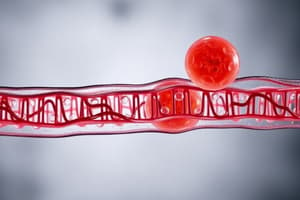Podcast
Questions and Answers
What is the function of mitochondria in eukaryotic cells?
What is the function of mitochondria in eukaryotic cells?
Generate energy through respiration
Which organelle assists in protein synthesis and transport?
Which organelle assists in protein synthesis and transport?
Endoplasmic reticulum
What is the main role of ribosomes within a cell?
What is the main role of ribosomes within a cell?
Facilitate translation of mRNA into proteins
Name the three main structural components of a cell.
Name the three main structural components of a cell.
What is the genetic material found in the nucleus of a cell?
What is the genetic material found in the nucleus of a cell?
Describe the function of the plasma membrane in a cell.
Describe the function of the plasma membrane in a cell.
What is the term used to refer to the smallest structural unit that constitutes living organisms?
What is the term used to refer to the smallest structural unit that constitutes living organisms?
How do cells come in terms of shapes and sizes?
How do cells come in terms of shapes and sizes?
What is the function of the cell membrane?
What is the function of the cell membrane?
What are vacuoles and what do they store?
What are vacuoles and what do they store?
Where are chloroplasts found and what is their main function?
Where are chloroplasts found and what is their main function?
How do cells adapt to their environments in terms of shape?
How do cells adapt to their environments in terms of shape?
Flashcards are hidden until you start studying
Study Notes
Unit of Life: Cell Structure
The term 'cell' refers to the smallest structural unit that constitutes living organisms. Cells come in many shapes and sizes, with functions ranging from simple to complex. They can exist independently (single cells) or combine together into tissues, organs, and other structures needed for the survival and function of larger organisms.
Cells are often characterized by their size and shape, which includes but is not limited to spherical, rod-like, branched, spindle-shaped, and flat forms. These characteristics help determine how they will interact within specific environments and what roles they may play in maintaining homeostasis of a system. For instance, cells exposed to rough terrains tend to have flatter shapes, while those residing in narrow spaces may be more elongated.
A crucial aspect of any cell is its membrane, which serves as both a boundary between the intracellular environment and extracellular space, and as a protective barrier against potentially damaging molecules outside the cell. Additionally, certain types of cells exhibit specialized compartments such as vacuoles or chloroplasts. Vacuoles store water, nutrients, waste products, and gases; they also serve as mechanisms for changing the volume and pressure inside the cell. Chloroplasts are found only in plant and algal cells, where they perform photosynthesis.
Organelles and Structural Components
Within each cell, there exists a diverse array of specialized structures known as organelles. While some cells lack them entirely, their presence is common among specialized cells like yeast. Some examples of important organelles include mitochondria, endoplasmic reticulum, Golgi apparatus, lysosomes, and ribosomes. Mitochondria generate energy through respiration in most eukaryotic cells, while the endoplasmic reticulum assists in protein synthesis and transport. Ribosomes facilitate translation—the process of converting mRNA code into proteins.
Structurally, all cells consist of three main components: cytoplasm, nucleus, and plasma membrane. Cytoplasm fills up the entire inner region of the cell; it comprises various fluid materials including organelles, vesicles, and secretory granules. By contrast, the nucleus contains the genetic material called DNA (deoxyribonucleic acid), responsible for directing the growth, functioning, repair, and reproduction of the cell. Lastly, the plasma membrane acts as the outer covering of the cell, separating it from its external environment. It allows passage of essential substances in and out of the cell, regulating its internal conditions accordingly.
In summary, understanding cell structure provides valuable insights into life itself. From their basic building blocks to their specialized components, cells form the foundation upon which we build our knowledge around biological systems.
Studying That Suits You
Use AI to generate personalized quizzes and flashcards to suit your learning preferences.




